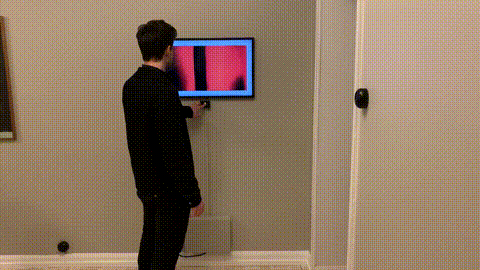The philosophical question of “What is art?” has an ethereal, transient quality to it. A definition seems to slip away as you get close to an answer. Embracing that quality, [Max Fischer] has created an AI-powered painting that paints a new piece of art at the push of a button. When the button below the screen is pushed, a new image is generated and the old one is forever lost, which in a way, makes the frame a piece of art itself.
The really makes this project stand is the sheer quality of documentation on the GitHub repo. The instructions are incredibly detailed. Everything from setting up the Jetson to building the control box out of half-inch MDF (12mm for the sane part of the world) is laid out with copious pictures. Despite the ease of generating images ahead of time, [Max] took the hard route Hackaday route and did all inference locally and in real-time. To handle the processing requirements, an Nvidia Jetson Xavier NX single-board computer was used. He trained StyleGAN with high-resolution abstract art that gets generated whenever the button below the screen is pushed. To prevent screen burn-in, a PIR was added to turn the screen off when no one is around.
Here at Hackaday, we’ve seen several projects putting old laptop screens or monitors into a nice wooden case and mounting them to the wall. Since 32″ laptops are rather hard to find, [Max] opted to take a different approach and instead got a 32″ Samsung Frame for relatively cheap.
For all their detail, [Max] did leave one thing out of the readme: the AI that generates the art. [Max] hints that he wants others to create their picture frames, but with their own art generation. So what are you waiting for? Go make some art.
















Serious question. What about the philosophical question of “What is pornography?” in the sense that does that have any correlation to this post’s question? What about completely computer / AI generated pornography?
Great project, with one fatal flaw that is not [Max Fischer’s] fault: At my writing time that USD $399 [1] NVIDIA® Jetson Xavier™ NX Developer Kit is out-of-stock nearly everywhere. If you can find one to buy, the hoarder/scalpers have jacked the price up by two to four orders of magnitude[2].
* References:
1. USD $399 @ Arrow and Seeed [No Stock]
https://www.seeedstudio.com/NVIDIA-Jetson-Xavier-NX-Developer-Kit-p-4573.html
https://www.arrow.com/en/products/945-83518-0000-000/nvidia
2. USD $809.99 to $1,599.98 @ Amazon [Stock Available]
https://www.amazon.com/NVIDIA-Jetson-Xavier-Developer-812674024318/dp/B086874Q5R
2 orders of magnitude would be multiplying the price by 100. That’d be a price of 39900 dollars. Nearly 40 thousand dollars. Never ever.
4 orders of magnitude would be multiplying the price by 10000. That’d be a price of 3990000 dollars. Nearly 4 million dollars. Nope, not gonna happen.
Your numbers (809 dollars and 1599.98 dollars) show a range of a factor of 2 to 4. Not an order of magnitude of 2 to 4.
OOPs. My Bad. Thanks.
It isn’t “Art”, the images are meaningless and the act of making the machine is so derivative of the work of others that at best you can only call it dynamic decorative design.
I’d argue the same is true of a lot of stuff made by people – but perhaps it’s my idea of art not lining up with their efforts.
The whole thing’s interesting, and while it might lack humanity, perhaps it’s absence is a potent symbol? I’d love to have it on my wall!
Art is what you can get away with, if you can get paid for taking a dump on the gallery floor it’s art.
I really like this project. My congratulations go out to [Max Fischer]. Some humble suggestions:
Remove the electronic border and have the AI generate frames that cover the entire screen border-to-border in never-ending timed intervals. Now the AI generated frames are random enough to prevent screen burn-in. If you still really want a border, cut-out a paper matte and glue it to the screen.
The button and PIR sensor can be removed or repurposed. For example: If someone likes one of the frames he or she pushes the button and notes down the unique filename shown which is comprised of the UTC date and time the image was generated (e.g. 2021-08-27_23-45-12.png). The image file will then be saved to a publicly accessible web page where it can be viewed and/or downloaded by anyone. All new files on the download page are stored first-in-last-out (FILO) for 24 hours. The files are stored and listed in temporal order because the filename is UTC date and time based. When a file is deleted that’s it, it will never be seen again.
This push-a-button to ‘save image and get a filename’ process could be greatly simplified with a QR code that appears. Also a Bluetooth connection would eliminate the physical button entirely as well as adding more controls like skip-a-frame, or save a frame directly.
The PIR sensor can be repurposed to turn the system off if there haven’t been any people in the room for a long time, and vice-versa when someone does enter the room again. This auto-on/off function is really needed in places like a waiting or hotel room.
I’m pretty sure the “lost forever when the button is pressed” is a deliberate feature. Art is ephemeral.
Most of your improvements serve to increase *function* but not *aesthetic appeal*.
I’m pretty sure the “lost forever when the button is pressed” is a deliberate feature. Art is ephemeral.
I agree, that’s why I included it.
Sadly there is no multi-color fast-refresh 32″ ePaper…
Screen burn-in on an LCD panel? This is the first I’ve heard about it.
On a plasma or OLED, sure, but there’s nothing to burn on an LCD (the backlight is on continuously and the LCD is acting as a shutter).
e-paper would look more like a standard artwork – reflective, not backlit.
e-paper is passive with no backlight…looks more “natural”